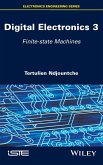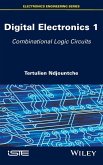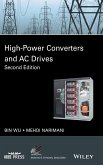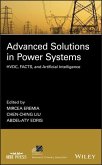- Gebundenes Buch
- Merkliste
- Auf die Merkliste
- Bewerten Bewerten
- Teilen
- Produkt teilen
- Produkterinnerung
- Produkterinnerung
The work presents the principles of combinational and sequential logic and the underlying techniques for the analysis and design of digital circuits. The approach is gradual and relatively independent of each other chapters. To facilitate the assimilation and practical implementation of various concepts, it is complemented by a selection of practical exercises corrected.
Andere Kunden interessierten sich auch für
![Digital Electronics 3 Digital Electronics 3]() Tertulien NdjountcheDigital Electronics 3169,99 €
Tertulien NdjountcheDigital Electronics 3169,99 €![Digital Electronics 1 Digital Electronics 1]() Tertulien NdjountcheDigital Electronics 1169,99 €
Tertulien NdjountcheDigital Electronics 1169,99 €![Power Electronics for Green Energy Conversion Power Electronics for Green Energy Conversion]() Power Electronics for Green Energy Conversion247,99 €
Power Electronics for Green Energy Conversion247,99 €![Electricity from Sunlight Electricity from Sunlight]() Vasilis M FthenakisElectricity from Sunlight86,99 €
Vasilis M FthenakisElectricity from Sunlight86,99 €![High-Power Converters and AC Drives High-Power Converters and AC Drives]() Bin WuHigh-Power Converters and AC Drives144,99 €
Bin WuHigh-Power Converters and AC Drives144,99 €![Renewable Energy Systems Renewable Energy Systems]() Renewable Energy Systems246,99 €
Renewable Energy Systems246,99 €![Advanced Solutions in Power Systems Advanced Solutions in Power Systems]() Advanced Solutions in Power Systems165,99 €
Advanced Solutions in Power Systems165,99 €-
-
-
The work presents the principles of combinational and sequential logic and the underlying techniques for the analysis and design of digital circuits. The approach is gradual and relatively independent of each other chapters. To facilitate the assimilation and practical implementation of various concepts, it is complemented by a selection of practical exercises corrected.
Hinweis: Dieser Artikel kann nur an eine deutsche Lieferadresse ausgeliefert werden.
Hinweis: Dieser Artikel kann nur an eine deutsche Lieferadresse ausgeliefert werden.
Produktdetails
- Produktdetails
- Verlag: Wiley
- Seitenzahl: 336
- Erscheinungstermin: 29. August 2016
- Englisch
- Abmessung: 240mm x 161mm x 22mm
- Gewicht: 663g
- ISBN-13: 9781848219854
- ISBN-10: 1848219857
- Artikelnr.: 44269073
- Herstellerkennzeichnung
- Libri GmbH
- Europaallee 1
- 36244 Bad Hersfeld
- gpsr@libri.de
- Verlag: Wiley
- Seitenzahl: 336
- Erscheinungstermin: 29. August 2016
- Englisch
- Abmessung: 240mm x 161mm x 22mm
- Gewicht: 663g
- ISBN-13: 9781848219854
- ISBN-10: 1848219857
- Artikelnr.: 44269073
- Herstellerkennzeichnung
- Libri GmbH
- Europaallee 1
- 36244 Bad Hersfeld
- gpsr@libri.de
Tertulien Ndjountche received a PhD degree in electrical engineering from Erlangen-Nuremberg University in Germany. He has worked as a professor and researcher at universities in Germany and Canada. He has published numerous technical papers and books in his fields of interest.
Preface ix
Chapter 1. Latch and Flip-Flop 1
1.1. Introduction 1
1.2. General overview 1
1.2.1. SR latch 6
1.2.2. S R latch 9
1.2.3. Application: switch debouncing 11
1.3. Gated SR latch 11
1.3.1. Implementation based on an SR latch 12
1.3.2. Implementation based on an S R latch 14
1.4. Gated D latch 15
1.5. Basic JK flip-flop 16
1.6. T flip-flop 18
1.7. Master-slave and edge-triggered flip-flop 20
1.7.1. Master-slave flip-flop 20
1.7.2. Edge-triggered flip-flop 24
1.8. Flip-flops with asynchronous inputs 30
1.9. Operational characteristics of flip-flops 33
1.10. Exercises 34
1.11. Solutions 39
Chapter 2. Binary Counters 51
2.1. Introduction 51
2.2. Modulo 4 counter 52
2.3. Modulo 8 counter 53
2.4. Modulo 16 counter 55
2.4.1. Modulo 10 counter 57
2.5. Counter with parallel load 60
2.6. Down counter 62
2.7. Synchronous reversible counter 64
2.8. Decoding a down counter 65
2.9. Exercises 66
2.10. Solutions 73
Chapter 3. Shift Register 85
3.1. Introduction 85
3.2. Serial-in shift register 85
3.3. Parallel-in shift register 85
3.4. Bidirectional shift register 88
3.5. Register file 90
3.6. Shift register based counter 91
3.6.1. Ring counter 92
3.6.2. Johnson counter 93
3.6.3. Linear feedback counter 94
3.7. Exercises 101
3.8. Solutions 107
Chapter 4. Arithmetic and Logic Circuits 117
4.1. Introduction 117
4.2. Adder 117
4.2.1. Half adder 117
4.2.2. Full adder 119
4.2.3. Ripple-carry adder 120
4.2.4. Carry-lookahead adder 122
4.2.5. Carry-select adder 124
4.2.6. Carry-skip adder 125
4.3. Comparator 127
4.4. Arithmetic and logic unit 129
4.5. Multiplier 136
4.5.1. Multiplier of 2-bit unsigned numbers 136
4.5.2. Multiplier of 4-bit unsigned numbers 137
4.5.3. Multiplier for signed numbers 138
4.6. Divider 143
4.7. Exercises 149
4.8. Solutions 158
Chapter 5. Digital Integrated Circuit Technology 177
5.1. Introduction 177
5.2. Characteristics of the technologies 177
5.2.1. Supply voltage 177
5.2.2. Logic levels 178
5.2.3. Immunity to noise 178
5.2.4. Propagation delay 179
5.2.5. Electric power consumption 179
5.2.6. Fan-out or load factor 179
5.3. TTL logic family 180
5.3.1. Bipolar junction transistor 180
5.3.2. TTL NAND gate 181
5.3.3. Integrated TTL circuit 182
5.4. CMOS logic family 183
5.4.1. MOSFET transistor 183
5.4.2. CMOS logic gates 184
5.5. Open drain logic gates 185
5.5.1. Three-state buffer 187
5.5.2. CMOS integrated circuit 188
5.6. Other logic families 189
5.7. Interfacing circuits of different technologies 189
5.8. Exercises 190
5.9. Solutions 193
Chapter 6. Semiconductor Memory 195
6.1. Introduction 195
6.2. Memory organization 195
6.3. Operation of a memory 197
6.4. Types of memory 199
6.4.1. Non-volatile memory 199
6.4.2. Volatile memories 202
6.4.3. Characteristics of the different memory types 207
6.5. Applications 207
6.5.1. Memory organization 208
6.5.2. Applications 209
6.6. Other types of memory 218
6.6.1. Ferromagnetic RAM 220
6.6.2. Content-addressable memory 222
6.6.3. Sequential access memory 223
6.7. Exercises 226
6.8. Solutions 230
Chapter 7. Programmable Logic Circuits 245
7.1. General overview 245
7.2. Programmable logic device 246
7.3. Applications 255
7.3.1. Implementation of logic functions 255
7.3.2. Two-bit adder 257
7.3.3. Binary-to-BCD and BCD-to-binary converters 263
7.4. Programmable logic circuits (CPLD and FPGA) 263
7.4.1. Principle and technology 264
7.4.2. CPLD 268
7.4.3. FPGA 270
7.5. References 274
7.6. Exercises 275
7.7. Solutions 284
Appendix 307
Bibliography 309
Index 311
Chapter 1. Latch and Flip-Flop 1
1.1. Introduction 1
1.2. General overview 1
1.2.1. SR latch 6
1.2.2. S R latch 9
1.2.3. Application: switch debouncing 11
1.3. Gated SR latch 11
1.3.1. Implementation based on an SR latch 12
1.3.2. Implementation based on an S R latch 14
1.4. Gated D latch 15
1.5. Basic JK flip-flop 16
1.6. T flip-flop 18
1.7. Master-slave and edge-triggered flip-flop 20
1.7.1. Master-slave flip-flop 20
1.7.2. Edge-triggered flip-flop 24
1.8. Flip-flops with asynchronous inputs 30
1.9. Operational characteristics of flip-flops 33
1.10. Exercises 34
1.11. Solutions 39
Chapter 2. Binary Counters 51
2.1. Introduction 51
2.2. Modulo 4 counter 52
2.3. Modulo 8 counter 53
2.4. Modulo 16 counter 55
2.4.1. Modulo 10 counter 57
2.5. Counter with parallel load 60
2.6. Down counter 62
2.7. Synchronous reversible counter 64
2.8. Decoding a down counter 65
2.9. Exercises 66
2.10. Solutions 73
Chapter 3. Shift Register 85
3.1. Introduction 85
3.2. Serial-in shift register 85
3.3. Parallel-in shift register 85
3.4. Bidirectional shift register 88
3.5. Register file 90
3.6. Shift register based counter 91
3.6.1. Ring counter 92
3.6.2. Johnson counter 93
3.6.3. Linear feedback counter 94
3.7. Exercises 101
3.8. Solutions 107
Chapter 4. Arithmetic and Logic Circuits 117
4.1. Introduction 117
4.2. Adder 117
4.2.1. Half adder 117
4.2.2. Full adder 119
4.2.3. Ripple-carry adder 120
4.2.4. Carry-lookahead adder 122
4.2.5. Carry-select adder 124
4.2.6. Carry-skip adder 125
4.3. Comparator 127
4.4. Arithmetic and logic unit 129
4.5. Multiplier 136
4.5.1. Multiplier of 2-bit unsigned numbers 136
4.5.2. Multiplier of 4-bit unsigned numbers 137
4.5.3. Multiplier for signed numbers 138
4.6. Divider 143
4.7. Exercises 149
4.8. Solutions 158
Chapter 5. Digital Integrated Circuit Technology 177
5.1. Introduction 177
5.2. Characteristics of the technologies 177
5.2.1. Supply voltage 177
5.2.2. Logic levels 178
5.2.3. Immunity to noise 178
5.2.4. Propagation delay 179
5.2.5. Electric power consumption 179
5.2.6. Fan-out or load factor 179
5.3. TTL logic family 180
5.3.1. Bipolar junction transistor 180
5.3.2. TTL NAND gate 181
5.3.3. Integrated TTL circuit 182
5.4. CMOS logic family 183
5.4.1. MOSFET transistor 183
5.4.2. CMOS logic gates 184
5.5. Open drain logic gates 185
5.5.1. Three-state buffer 187
5.5.2. CMOS integrated circuit 188
5.6. Other logic families 189
5.7. Interfacing circuits of different technologies 189
5.8. Exercises 190
5.9. Solutions 193
Chapter 6. Semiconductor Memory 195
6.1. Introduction 195
6.2. Memory organization 195
6.3. Operation of a memory 197
6.4. Types of memory 199
6.4.1. Non-volatile memory 199
6.4.2. Volatile memories 202
6.4.3. Characteristics of the different memory types 207
6.5. Applications 207
6.5.1. Memory organization 208
6.5.2. Applications 209
6.6. Other types of memory 218
6.6.1. Ferromagnetic RAM 220
6.6.2. Content-addressable memory 222
6.6.3. Sequential access memory 223
6.7. Exercises 226
6.8. Solutions 230
Chapter 7. Programmable Logic Circuits 245
7.1. General overview 245
7.2. Programmable logic device 246
7.3. Applications 255
7.3.1. Implementation of logic functions 255
7.3.2. Two-bit adder 257
7.3.3. Binary-to-BCD and BCD-to-binary converters 263
7.4. Programmable logic circuits (CPLD and FPGA) 263
7.4.1. Principle and technology 264
7.4.2. CPLD 268
7.4.3. FPGA 270
7.5. References 274
7.6. Exercises 275
7.7. Solutions 284
Appendix 307
Bibliography 309
Index 311
Preface ix
Chapter 1. Latch and Flip-Flop 1
1.1. Introduction 1
1.2. General overview 1
1.2.1. SR latch 6
1.2.2. S R latch 9
1.2.3. Application: switch debouncing 11
1.3. Gated SR latch 11
1.3.1. Implementation based on an SR latch 12
1.3.2. Implementation based on an S R latch 14
1.4. Gated D latch 15
1.5. Basic JK flip-flop 16
1.6. T flip-flop 18
1.7. Master-slave and edge-triggered flip-flop 20
1.7.1. Master-slave flip-flop 20
1.7.2. Edge-triggered flip-flop 24
1.8. Flip-flops with asynchronous inputs 30
1.9. Operational characteristics of flip-flops 33
1.10. Exercises 34
1.11. Solutions 39
Chapter 2. Binary Counters 51
2.1. Introduction 51
2.2. Modulo 4 counter 52
2.3. Modulo 8 counter 53
2.4. Modulo 16 counter 55
2.4.1. Modulo 10 counter 57
2.5. Counter with parallel load 60
2.6. Down counter 62
2.7. Synchronous reversible counter 64
2.8. Decoding a down counter 65
2.9. Exercises 66
2.10. Solutions 73
Chapter 3. Shift Register 85
3.1. Introduction 85
3.2. Serial-in shift register 85
3.3. Parallel-in shift register 85
3.4. Bidirectional shift register 88
3.5. Register file 90
3.6. Shift register based counter 91
3.6.1. Ring counter 92
3.6.2. Johnson counter 93
3.6.3. Linear feedback counter 94
3.7. Exercises 101
3.8. Solutions 107
Chapter 4. Arithmetic and Logic Circuits 117
4.1. Introduction 117
4.2. Adder 117
4.2.1. Half adder 117
4.2.2. Full adder 119
4.2.3. Ripple-carry adder 120
4.2.4. Carry-lookahead adder 122
4.2.5. Carry-select adder 124
4.2.6. Carry-skip adder 125
4.3. Comparator 127
4.4. Arithmetic and logic unit 129
4.5. Multiplier 136
4.5.1. Multiplier of 2-bit unsigned numbers 136
4.5.2. Multiplier of 4-bit unsigned numbers 137
4.5.3. Multiplier for signed numbers 138
4.6. Divider 143
4.7. Exercises 149
4.8. Solutions 158
Chapter 5. Digital Integrated Circuit Technology 177
5.1. Introduction 177
5.2. Characteristics of the technologies 177
5.2.1. Supply voltage 177
5.2.2. Logic levels 178
5.2.3. Immunity to noise 178
5.2.4. Propagation delay 179
5.2.5. Electric power consumption 179
5.2.6. Fan-out or load factor 179
5.3. TTL logic family 180
5.3.1. Bipolar junction transistor 180
5.3.2. TTL NAND gate 181
5.3.3. Integrated TTL circuit 182
5.4. CMOS logic family 183
5.4.1. MOSFET transistor 183
5.4.2. CMOS logic gates 184
5.5. Open drain logic gates 185
5.5.1. Three-state buffer 187
5.5.2. CMOS integrated circuit 188
5.6. Other logic families 189
5.7. Interfacing circuits of different technologies 189
5.8. Exercises 190
5.9. Solutions 193
Chapter 6. Semiconductor Memory 195
6.1. Introduction 195
6.2. Memory organization 195
6.3. Operation of a memory 197
6.4. Types of memory 199
6.4.1. Non-volatile memory 199
6.4.2. Volatile memories 202
6.4.3. Characteristics of the different memory types 207
6.5. Applications 207
6.5.1. Memory organization 208
6.5.2. Applications 209
6.6. Other types of memory 218
6.6.1. Ferromagnetic RAM 220
6.6.2. Content-addressable memory 222
6.6.3. Sequential access memory 223
6.7. Exercises 226
6.8. Solutions 230
Chapter 7. Programmable Logic Circuits 245
7.1. General overview 245
7.2. Programmable logic device 246
7.3. Applications 255
7.3.1. Implementation of logic functions 255
7.3.2. Two-bit adder 257
7.3.3. Binary-to-BCD and BCD-to-binary converters 263
7.4. Programmable logic circuits (CPLD and FPGA) 263
7.4.1. Principle and technology 264
7.4.2. CPLD 268
7.4.3. FPGA 270
7.5. References 274
7.6. Exercises 275
7.7. Solutions 284
Appendix 307
Bibliography 309
Index 311
Chapter 1. Latch and Flip-Flop 1
1.1. Introduction 1
1.2. General overview 1
1.2.1. SR latch 6
1.2.2. S R latch 9
1.2.3. Application: switch debouncing 11
1.3. Gated SR latch 11
1.3.1. Implementation based on an SR latch 12
1.3.2. Implementation based on an S R latch 14
1.4. Gated D latch 15
1.5. Basic JK flip-flop 16
1.6. T flip-flop 18
1.7. Master-slave and edge-triggered flip-flop 20
1.7.1. Master-slave flip-flop 20
1.7.2. Edge-triggered flip-flop 24
1.8. Flip-flops with asynchronous inputs 30
1.9. Operational characteristics of flip-flops 33
1.10. Exercises 34
1.11. Solutions 39
Chapter 2. Binary Counters 51
2.1. Introduction 51
2.2. Modulo 4 counter 52
2.3. Modulo 8 counter 53
2.4. Modulo 16 counter 55
2.4.1. Modulo 10 counter 57
2.5. Counter with parallel load 60
2.6. Down counter 62
2.7. Synchronous reversible counter 64
2.8. Decoding a down counter 65
2.9. Exercises 66
2.10. Solutions 73
Chapter 3. Shift Register 85
3.1. Introduction 85
3.2. Serial-in shift register 85
3.3. Parallel-in shift register 85
3.4. Bidirectional shift register 88
3.5. Register file 90
3.6. Shift register based counter 91
3.6.1. Ring counter 92
3.6.2. Johnson counter 93
3.6.3. Linear feedback counter 94
3.7. Exercises 101
3.8. Solutions 107
Chapter 4. Arithmetic and Logic Circuits 117
4.1. Introduction 117
4.2. Adder 117
4.2.1. Half adder 117
4.2.2. Full adder 119
4.2.3. Ripple-carry adder 120
4.2.4. Carry-lookahead adder 122
4.2.5. Carry-select adder 124
4.2.6. Carry-skip adder 125
4.3. Comparator 127
4.4. Arithmetic and logic unit 129
4.5. Multiplier 136
4.5.1. Multiplier of 2-bit unsigned numbers 136
4.5.2. Multiplier of 4-bit unsigned numbers 137
4.5.3. Multiplier for signed numbers 138
4.6. Divider 143
4.7. Exercises 149
4.8. Solutions 158
Chapter 5. Digital Integrated Circuit Technology 177
5.1. Introduction 177
5.2. Characteristics of the technologies 177
5.2.1. Supply voltage 177
5.2.2. Logic levels 178
5.2.3. Immunity to noise 178
5.2.4. Propagation delay 179
5.2.5. Electric power consumption 179
5.2.6. Fan-out or load factor 179
5.3. TTL logic family 180
5.3.1. Bipolar junction transistor 180
5.3.2. TTL NAND gate 181
5.3.3. Integrated TTL circuit 182
5.4. CMOS logic family 183
5.4.1. MOSFET transistor 183
5.4.2. CMOS logic gates 184
5.5. Open drain logic gates 185
5.5.1. Three-state buffer 187
5.5.2. CMOS integrated circuit 188
5.6. Other logic families 189
5.7. Interfacing circuits of different technologies 189
5.8. Exercises 190
5.9. Solutions 193
Chapter 6. Semiconductor Memory 195
6.1. Introduction 195
6.2. Memory organization 195
6.3. Operation of a memory 197
6.4. Types of memory 199
6.4.1. Non-volatile memory 199
6.4.2. Volatile memories 202
6.4.3. Characteristics of the different memory types 207
6.5. Applications 207
6.5.1. Memory organization 208
6.5.2. Applications 209
6.6. Other types of memory 218
6.6.1. Ferromagnetic RAM 220
6.6.2. Content-addressable memory 222
6.6.3. Sequential access memory 223
6.7. Exercises 226
6.8. Solutions 230
Chapter 7. Programmable Logic Circuits 245
7.1. General overview 245
7.2. Programmable logic device 246
7.3. Applications 255
7.3.1. Implementation of logic functions 255
7.3.2. Two-bit adder 257
7.3.3. Binary-to-BCD and BCD-to-binary converters 263
7.4. Programmable logic circuits (CPLD and FPGA) 263
7.4.1. Principle and technology 264
7.4.2. CPLD 268
7.4.3. FPGA 270
7.5. References 274
7.6. Exercises 275
7.7. Solutions 284
Appendix 307
Bibliography 309
Index 311








